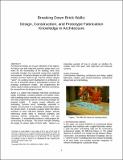| dc.contributor.author | Villalon, Rachelle | |
| dc.contributor.author | Lieberman, Henry A. | |
| dc.contributor.author | Sass, Larry | |
| dc.date.accessioned | 2013-01-30T17:12:26Z | |
| dc.date.available | 2013-01-30T17:12:26Z | |
| dc.date.issued | 2009-04 | |
| dc.identifier.isbn | 978-1-60558-247-4 | |
| dc.identifier.uri | http://hdl.handle.net/1721.1/76663 | |
| dc.description.abstract | Architectural designs are not just collections of 3D objects. Architects have both high-level aesthetic design intent, and intent for the functionality of the building; these must eventually translate into real-world construction materials and processes. Physical prototypes are still essential for the architect and their clients to get a feel for whether designs "work". An exciting recent development in architecture is the use of industrial robots to automatically construct 3D prototype architectural models. But programming the robots requires tedious procedures of low-level commands, far removed from the designer's intent.
Adeon is a system that integrates high-level architectural design knowledge, including aesthetic and stylistic intent, with knowledge about materials and construction processes, and robot programming code for constructing prototype 3D physical models. It centers around collecting and associating "common sense" knowledge, expressed in English and converted to a knowledge representation about the various levels. It provides a graphic editor that allows architects to draw high-level aesthetic designs, perhaps referencing known styles or historical examples, and retrieving relevant construction, materials, and cost information. It automatically produces a robot program for constructing the prototype. We present examples detailing the design of various styles of brick walls. Adeon is an interesting example of how to provide an interface for creative work that spans both high-level and low-level concerns. | en_US |
| dc.language.iso | en_US | |
| dc.publisher | Association for Computing Machinery (ACM) | en_US |
| dc.relation.isversionof | http://dx.doi.org/10.1145/1520340.1520650 | en_US |
| dc.rights | Creative Commons Attribution-Noncommercial-Share Alike 3.0 | en_US |
| dc.rights.uri | http://creativecommons.org/licenses/by-nc-sa/3.0/ | en_US |
| dc.source | MIT web domain | en_US |
| dc.title | Breaking down brick walls: Design, construction, and prototype fabrication knowledge in architecture | en_US |
| dc.type | Article | en_US |
| dc.identifier.citation | Rachelle Villalon, Henry Lieberman, and Larry Sass. 2009. "Breaking down brick walls: design, construction, and prototype fabrication knowledge in architecture." Proceedings of the 2009 Extended Abstracts on Human Factors in Computing Systems (CHI EA '09) (2009): 4261-4266. | en_US |
| dc.contributor.department | Massachusetts Institute of Technology. Department of Architecture | en_US |
| dc.contributor.department | Massachusetts Institute of Technology. Media Laboratory | en_US |
| dc.contributor.mitauthor | Villalon, Rachelle | |
| dc.contributor.mitauthor | Lieberman, Henry A. | |
| dc.contributor.mitauthor | Sass, Larry | |
| dc.relation.journal | Proceedings of the 2009 Extended Abstracts on Human Factors in Computing Systems (CHI EA '09) | en_US |
| dc.eprint.version | Author's final manuscript | en_US |
| dc.type.uri | http://purl.org/eprint/type/JournalArticle | en_US |
| eprint.status | http://purl.org/eprint/status/PeerReviewed | en_US |
| dspace.orderedauthors | Villalon, Rachelle; Lieberman, Henry; Sass, Larry | en |
| dc.identifier.orcid | https://orcid.org/0000-0003-2763-1016 | |
| dc.identifier.orcid | https://orcid.org/0000-0003-0584-6382 | |
| mit.license | OPEN_ACCESS_POLICY | en_US |
| mit.metadata.status | Complete | |
